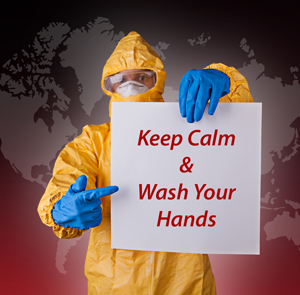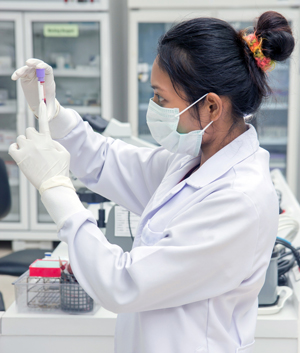Phlebotomists and Covid-19
How to minimize the risks for phlebotomists
by Dennis Ernst • April 06, 2020

Nobody is untouched by the Covid-19 pandemic. A virus 40 times smaller than a red blood cell has swept all that is normal and routine aside, replacing them with the unfamiliar and, at times, chaotic. For those who draw blood samples from patients, the risk of acquiring coronavirus must be taken seriously. Because the simple and necessary practice of drawing blood samples requires close contact for 4-6 minutes per patient, longer for difficult draws, phlebotomists and their managers must work closely with infection control professionals to minimize the potential for exposure. It's not as simple as applying standard precautions, a concept familiar to all healthcare professionals. Assuming all patients are potentially infectious coronavirus carriers requires all phlebotomists to wear N95 masks when drawing blood samples, but the demand exceeds the supply, at least for now. So how do we minimize the risk?
The current buzz
The Center for Phlebotomy Education has been voraciously consuming information and CDC reports to answer that very question. This much we know for sure: the situation is extremely fluid and the flow of phlebotomy-specific information is scant. Nevertheless, we have culled sufficient information from a wide variety of sources to confidently deliver what phlebotomists and their educators and managers need to know in order to understand the risk and implement the most appropriate precautions.
1) Don't panic. This will pass. If you're healthy and catch the virus, your chances of recovering from it are excellent. Just protect yourself according to your facility's policies and protect everyone you come in contact with. By the time you read this, your employer will have fully assessed your risk and has likely implemented all means possible to protect you. Your employer needs you now more than ever. Trust them.
2) Distance yourself. You've heard this a thousand times. This makes a thousand and one. Stop breathing what's coming out of other people's lungs by staying at least 6 feet away from all but those for whom closer contact is necessary. If you have an N95 mask wear it, especially around patients. It protects everyone from you and you from everyone. If you don't have a mask, you're in the majority. Distance yourself.
3) Wash and gel. On average, people touch their face about 90 times a day. Stop touching your face. Because most of us do so without even knowing it, wash or gel your hands twice as often as you ever did, even more. Consider everything you touch will likely end up on your face and close to where you can breathe it into your lungs.
4) Glove up. It's likely that you're already doing this for every patient. If you're not, it's time to create the habit. It's never been more important. Just remember, it's not only about protecting you and your patient from exchanging pathogens. Gloves spread bugs far and wide just as easily as bare hands will. So immediately after every draw and before you part ways with the patient, remove and discard them. Then gel or wash your hands immediately. The longer you wear the same pair after leaving the patient the farther you spread disease-causing organisms.

Masks: wear 'em if ya got 'em
Because of the shortage of N95 masks, most facilities are prioritizing their inventory for their highest-risk personnel. Those in contact with known Covid-19 patients and their samples and those with the symptoms of being infected (i.e., fever, cough, and difficulty breathing) would be given the highest priority. As inventories increase, other healthcare personnel can be protected on an order of decreasing risk. For example, those who have contact with asymptomatic patients, such as phlebotomists, are at a lower risk than those who are in contact with environments where known Covid-19 patients or symptomatic patients were treated, such as housekeeping personnel in a hospital or clinic staff in exam rooms. Not that phlebotomists have no risk, but their risk of acquiring the virus from asymptomatic patients is much less certain.
What the CDC says
As of early April, no phlebotomy- or phlebotomist-specific guidelines have been issued by the CDC. However, new Covid-19 recommendations have been posted for drawing blood from donors. These recommendations, including decontaminating surfaces after ever draw, may be applicable until more specific guidance is available for diagnostic phlebotomy procedures. It's important to note that routine blood donor screening measures prevent individuals with clinical respiratory infections from donating blood. Those who draw diagnostic blood samples are at far greater risk.
Perhaps the most helpful publication for all healthcare professionals is the CDC's Interim U.S. Guidance for Risk Assessment and Public Health Management of Healthcare Personnel with Potential Exposure in a Healthcare Setting to Patients with Coronavirus Disease (COVID-19) published March 7, 2020. It provides guidance for those who have "close contact" with patients potentially infected with Covid-19. (Editor's note: even though the article oddly excludes clinical laboratory personnel as "healthcare personnel," we feel the information contained in it is relevant to those who draw blood samples in the absence of more phlebotomist-specific recommendations.)
The agency defines "close contact" as:
"a) being within approximately 6 feet (2 meters), of a person with COVID-19 for a prolonged period of time (such as caring for or visiting the patient; or sitting within 6 feet of the patient in a healthcare waiting area or room); or
"b) having unprotected direct contact with infectious secretions or excretions of the patient (e.g., being coughed on, touching used tissues with a bare hand)."
According to the article, defining "prolonged period of time" is difficult, but it suggests "it is reasonable to consider an exposure greater than a few minutes as a prolonged exposure. Brief interactions are less likely to result in transmission; however, clinical symptoms of the patient and type of interaction (e.g., did the patient cough directly into the face of the HCP) remain important."
The article goes on to provide guidance on how to react to exposures to known Covid-19 patients. Yet beyond those with the obvious symptoms, defining which patients constitute a "potential exposure" risk seems to be elusive. The agency does state "all HCP are at some risk for exposure to COVID-19." Therefore, given the rapid spread of the coronavirus since the article was published and the virus's asymptomatic incubation phase lasting up to 14 days, every facility should establish what constitutes potential exposure with input from infection control professionals.
On April 3, 2020, the CDC issued a recommendation that cloth face coverings be "worn in public settings where other social distancing measures are difficult to maintain (e.g., grocery stores and pharmacies) especially in areas of significant community-based transmission." Recommendation Regarding the Use of Cloth Face Coverings, Especially in Areas of Significant Community-Based Transmission states "the virus can spread between people interacting in close proximity—for example, speaking, coughing, or sneezing—even if those people are not exhibiting symptoms." The agency clarifies "cloth face coverings" as not including surgical masks or N-95 respirators, which must be conserved for high-risk exposures. Though not mandated for healthcare professionals who draw blood samples from patients, phlebotomists cannot maintain what the agency considers a safe distance from their patients (six feet). Therefore, the recommendation for phlebotomists to wear cloth face masks seems a logical conclusion. Although neither paper nor fiber masks are mentioned in the article as equivalent, a companion article includes the use of a coffee filter for those making masks at home. Use of Cloth Face Coverings to Help Slow the Spread of COVID-19 is posted on the CDC web site providing instructions.
On March 31, 2020, The Joint Commission released a statement supporting the use of standard face masks provided from home when health care organizations cannot provide them.
For those interested, the CDC hosts a Clinical Laboratory COVID-19 Response Call every Monday at 3:00 PM EDT. Audio and transcripts are posted here.
Related Posts and Information
overall rating: my rating: log in to rate
